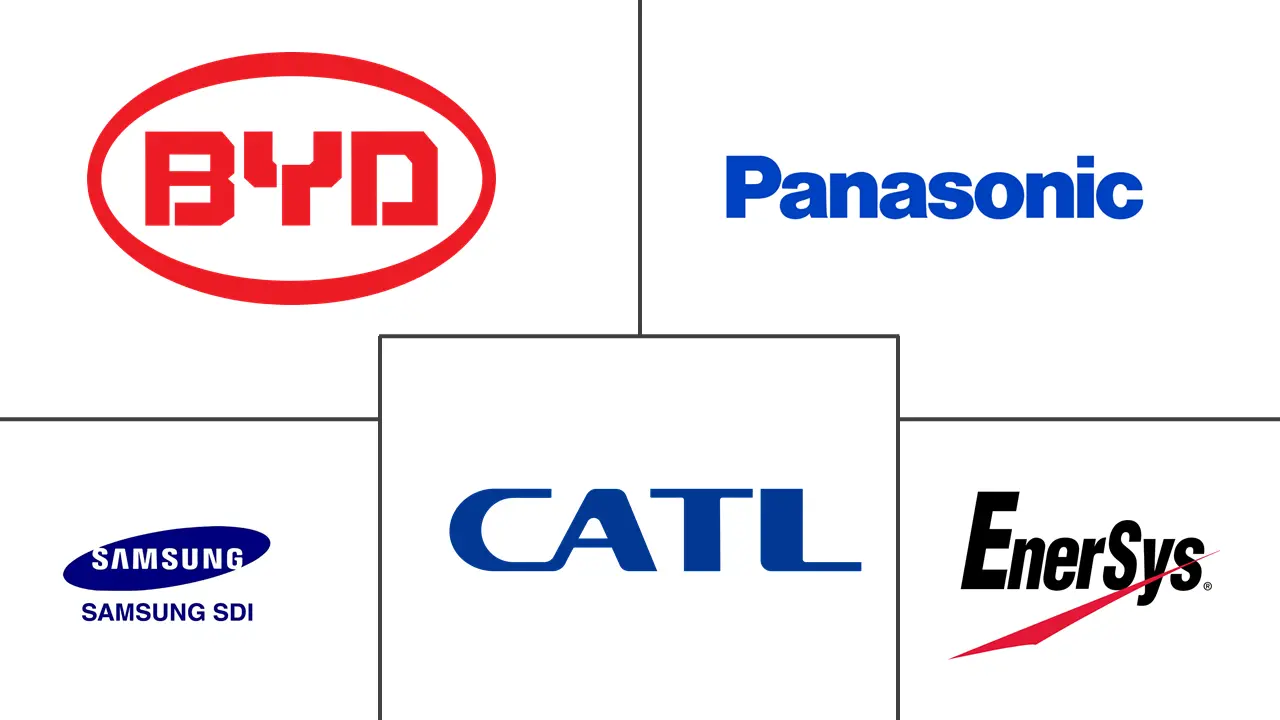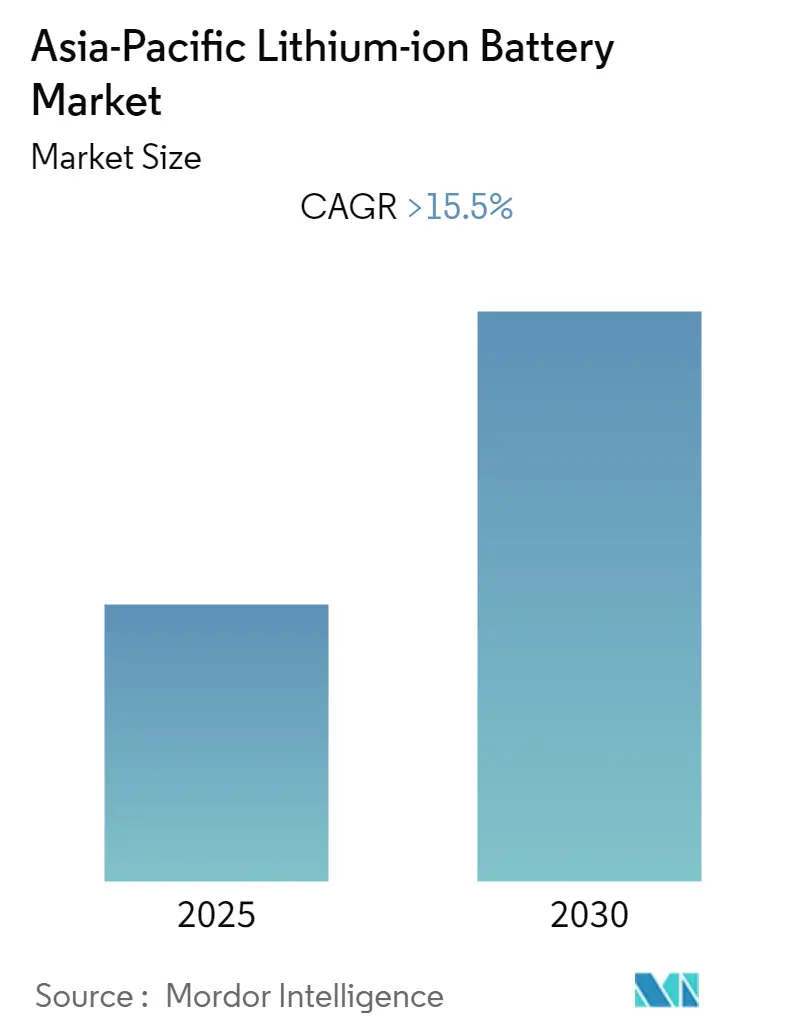
Asia-Pacific Lithium-ion Battery Market Analysis by Mordor Intelligence
The Asia-Pacific Lithium-ion Battery Market is expected to register a CAGR of greater than 15.5% during the forecast period.
The automotive sector is expected to be one of the major end-user segments for lithium-ion batteries in the near future. The penetration of electric vehicles is anticipated to provide a massive impetus for the lithium-ion battery industry growth.
A significant fraction of Asia-Pacific's population is estimated to be living without access to electricity and is dependent on conventional fuels, such as kerosene and diesel, for their lighting and mobile phone charging needs. Lithium-ion battery integrated energy storage solutions are likely to witness an increasing rate of adoption due to the technical benefits associated with them and declining lithium-ion battery prices. This, in turn, is expected to create a significant number of opportunities for the Li-ion battery manufacturers in the near future.
China is likely to be the dominant player in the Asia-Pacific lithium-ion battery market, supported by increasing urbanization, consumer spending, and electric vehicle (EV) market growth.
Asia-Pacific Lithium-ion Battery Market Trends and Insights
The Automotive Batteries Segment is Expected to be the Fastest-growing Segment
The automotive sector is expected to be one of the major end-user segments for lithium-ion batteries in the near future. The penetration of electric vehicles is anticipated to provide a massive impetus for the lithium-ion battery industry growth in Asia-Pacific.
A range of different vehicle types is now available, featuring increasing degrees of hybridization and electrification. There are various types of vehicles, including hybrid electric vehicles (HEVs), plug-in hybrid electric vehicles, and electric vehicles (EVs).
In developed and developing economies, both alike, the adoption of electric vehicles is increasing at a high growth rate. For instance, according to the China Association of Automobile Manufacturers (AMMA), in 2020, China was the largest market for electric vehicles (EV), with an estimated 1.12 million battery electric vehicles (BEVs) being sold, and it is expected to remain the world's largest electric car market during the forecast period.
Similarly, as of 2021, India is already among the countries leading in global EV sales, along with other developing economies, and it has already begun transforming its public transportation infrastructure for EVs.
India has been witnessing a surge in the manufacturing of lithium-ion batteries locally due to the government's thrust on e-mobility. The Indian government aims to achieve a 30% electric fleet by 2030. Also, in July 2019, the Indian government announced income tax exemptions for prospective EV buyers and reduced goods and services tax (GST) on EVs from 12% to 5%. In March 2019, the country's government approved setting up a National Mission on Transformative Mobility and Battery Storage to drive clean and sustainable mobility initiatives with a 5-year phased manufacturing program (PMP) till 2024.
The battery-electric vehicles market in Asia-Pacific has been heavily fueled by the presence of several competitors, backed up by the generous support of the government. For instance, China extended the incentives related to the purchase of new energy vehicles (NEVs) till 2022.
Some non-automotive companies, like Alibaba, are also entering the rapidly growing EV market in the country. For instance, in January 2021, Alibaba Group introduced two electric models in the country, under the IM label (Intelligence in Motion), in partnership with SAIC Motor. Battery cells for these vehicles are supplied by CATL.
Of the two models launched, one is an electric sedan, and the other is an electric SUV. The sedan is expected to be launched first, with the presale starting at Auto China 2021 in April, and the SUV may hit the market in 2022. The company has informed that the vehicles may be offered with a 93 kWh battery, while a 115 kWh battery will be available as an option. Hence, the sedan may provide a range of up to 874 km in the NEDC cycle. Thus, such upcoming electric vehicles are likely to increase the demand for lithium-ion batteries in the region during the forecast period.
In the current market scenario, policy support is expected to play a crucial role in driving the adoption of electric vehicles. Policy support enables market growth by making vehicles appealing to consumers, reducing risks for investors, and encouraging manufacturers to develop electric vehicles on a large scale. This, in turn, is expected to boost the demand for lithium-ion batteries in the Asia-Pacific region during the forecast period.
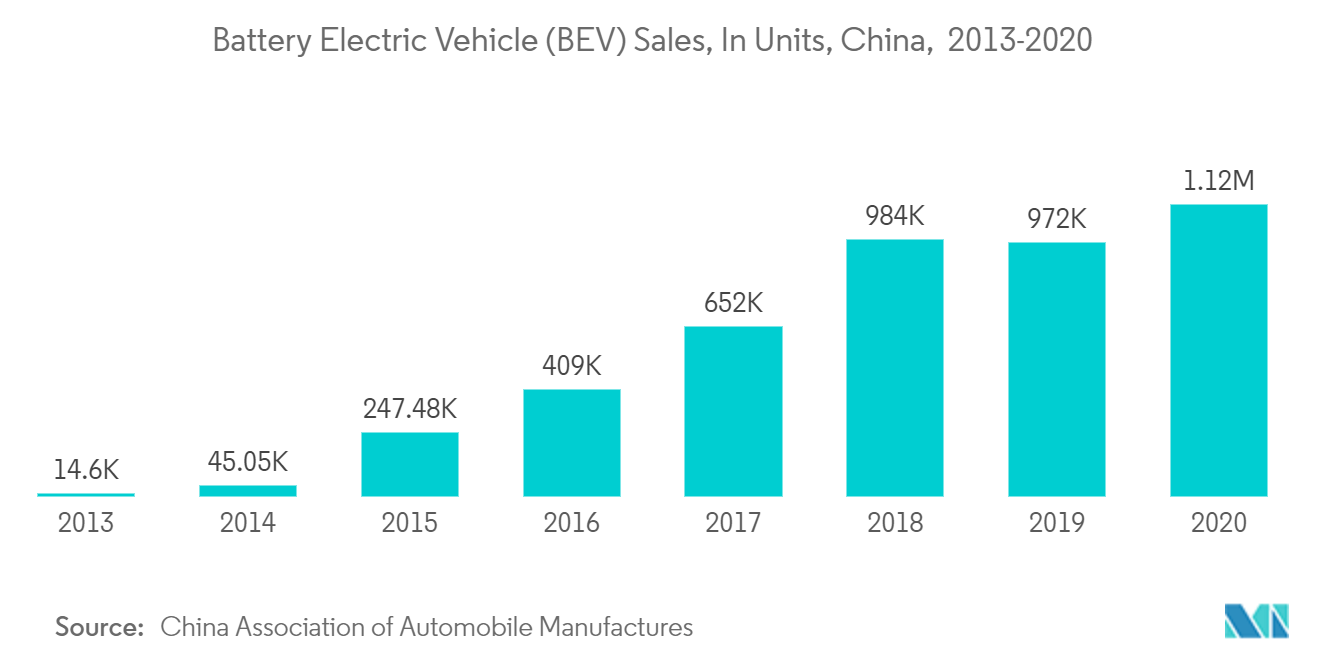
China is Driving the Market Demand
The Asia-Pacific region has multiple growing economies with substantial natural as well as human resources. China and India are expected to be major investment hotspots for lithium-ion battery companies in the coming years on account of policy-level support from the governments for both renewables and EVs and a growing middle-class population creating demand for consumer electronics.
India has been witnessing a surge in manufacturing lithium-ion batteries locally, owing to the government's thrust on e-mobility. The Indian government aims to achieve a 30% electric fleet by 2030 and has been formulating policies and programs to achieve the target. For instance, in 2021, the government amended the ongoing FAME-II (Faster Adoption and Manufacturing of Electric Vehicles-II) scheme to increase the subsidy rate for electric vehicles from INR 10,000/kWh to INR 15,000/kWh to reduce the gap between petrol-powered two-wheelers and electric powered.
According to the China Association of Automobile Manufacturers (AMMA), in 2020, China was the largest market for electric vehicles (EV), with an estimated 0.251 million plug-in hybrid Electric vehicles (PHEVs) and 1.12 million battery electric vehicles (BEVs) being sold. It is expected to remain the world's largest electric car market during the forecast period.
China is further expected to dominate, with a 57% share of the global EV market by 2030. The adoption of EVs in the country is further being propelled by the development of charging infrastructure. According to IEA, China had aimed to deploy 1,200 stations for swapping batteries and 500,000 publicly accessible chargers to serve 5 million EVs by 2020.
The increasing adoption of electric vehicles is in line with the clean energy policy. In order to reduce the demand-supply gap, the government of China is planning to ease restrictions on automakers importing cars into the country.
This is expected to ramp up the demand for technically advanced devices and vehicles due to the benefits provided by the same, leading to a growth in demand for lithium-ion batteries.
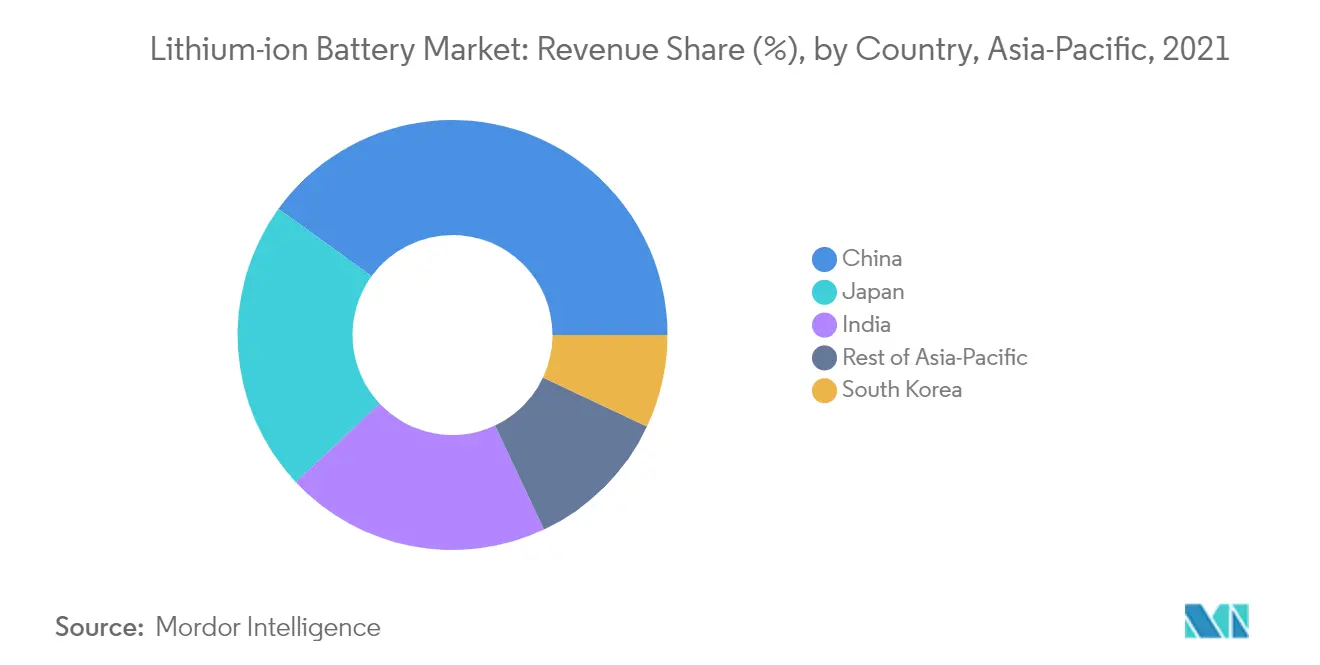
Competitive Landscape
The Asia-Pacific lithium-ion battery market is fragmented. Some of the key players in this market are Contemporary Amperex Technology Co. Limited, BYD Co. Ltd, Samsung SDI Co. Ltd, Panasonic Corporation, and EnerSys, among others.
Asia-Pacific Lithium-ion Battery Industry Leaders
-
Samsung SDI Co. Ltd.
-
Panasonic Corporation
-
Contemporary Amperex Technology Co Ltd.
-
EnerSys
-
BYD Co. Ltd.
- *Disclaimer: Major Players sorted in no particular order
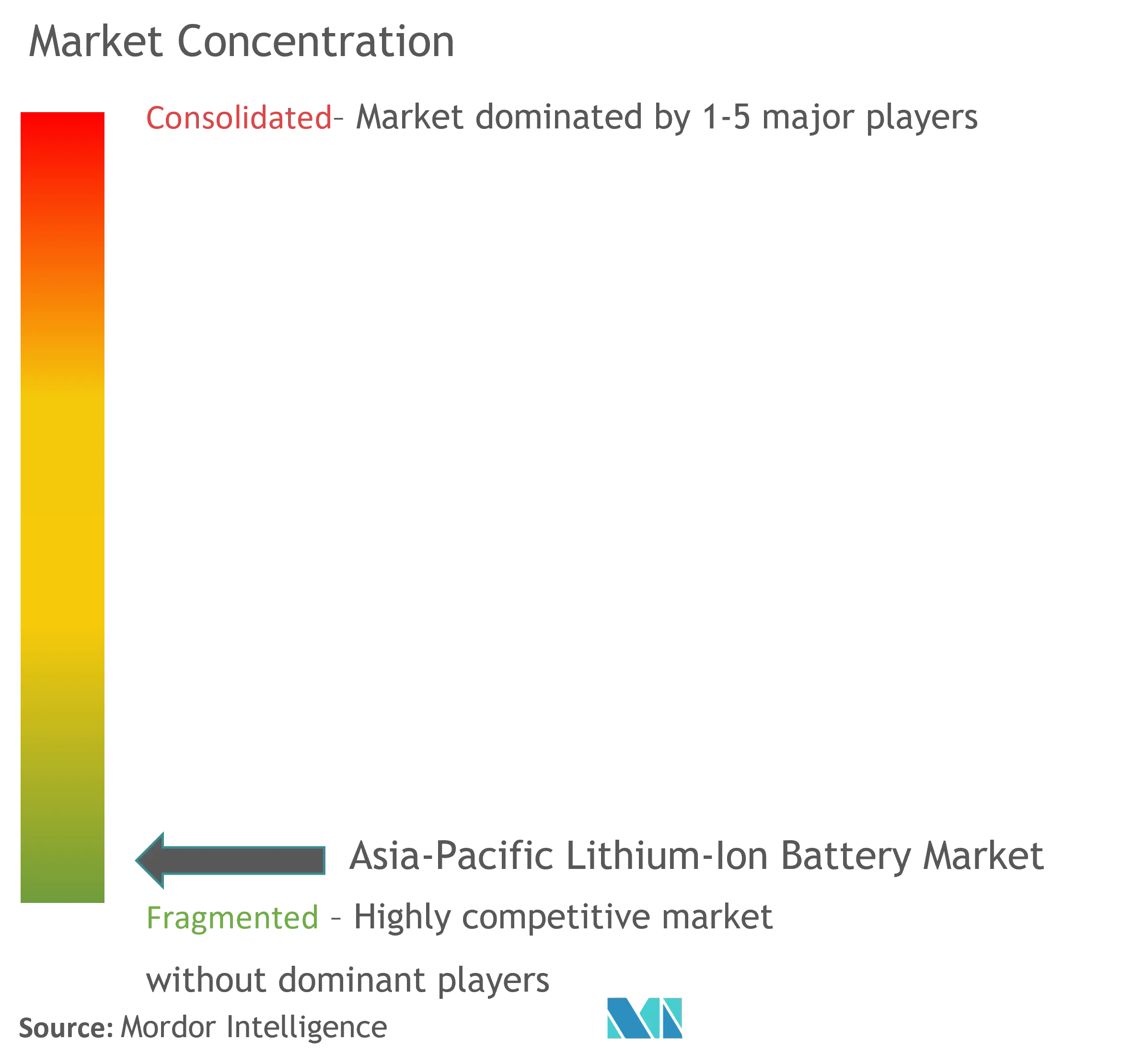
Recent Industry Developments
- September 2021: Exide Industries announced plans to set up a multi-gigawatt lithium-ion cell manufacturing plant in India. It also plans to apply for and participate in the Production-Linked Incentive Scheme for National Programme on Advanced Chemistry Cell (ACC) battery Storage, issued by the Ministry of Heavy Industries.
- July 2021: Energy Renaissance started the construction of Australia's first lithium-ion battery production facility, and it plans to produce EV batteries tailored for Australian weather conditions. Such steps are likely to reduce the reliance on battery imports from other countries. They are likely to encourage the battery manufacturers to produce EV batteries locally, in turn, improving prospects for demand in the region.
- March 2021: Ola Electric announced a plan to set up a cell manufacturing plant to power its lithium-ion (Li-ion) battery. The battery manufacturing plant will be made in the upcoming integrated plant near Bengaluru, India, where the e-scooter will also be manufactured.
Asia-Pacific Lithium-ion Battery Market Report Scope
The Asia-Pacific lithium-ion battery market report includes:
| Automotive Batteries |
| Industrial Batteries |
| Consumer Electronics Batteries |
| Other Applications |
| India |
| China |
| Japan |
| South Korea |
| Rest of Asia-Pacifc |
| Application | Automotive Batteries |
| Industrial Batteries | |
| Consumer Electronics Batteries | |
| Other Applications | |
| Geography | India |
| China | |
| Japan | |
| South Korea | |
| Rest of Asia-Pacifc |
Key Questions Answered in the Report
What is the current Asia-Pacific Lithium-ion Battery Market size?
The Asia-Pacific Lithium-ion Battery Market is projected to register a CAGR of greater than 15.5% during the forecast period (2025-2030)
Who are the key players in Asia-Pacific Lithium-ion Battery Market?
Samsung SDI Co. Ltd., Panasonic Corporation, Contemporary Amperex Technology Co Ltd., EnerSys and BYD Co. Ltd. are the major companies operating in the Asia-Pacific Lithium-ion Battery Market.
What years does this Asia-Pacific Lithium-ion Battery Market cover?
The report covers the Asia-Pacific Lithium-ion Battery Market historical market size for years: 2020, 2021, 2022, 2023 and 2024. The report also forecasts the Asia-Pacific Lithium-ion Battery Market size for years: 2025, 2026, 2027, 2028, 2029 and 2030.
Page last updated on:
